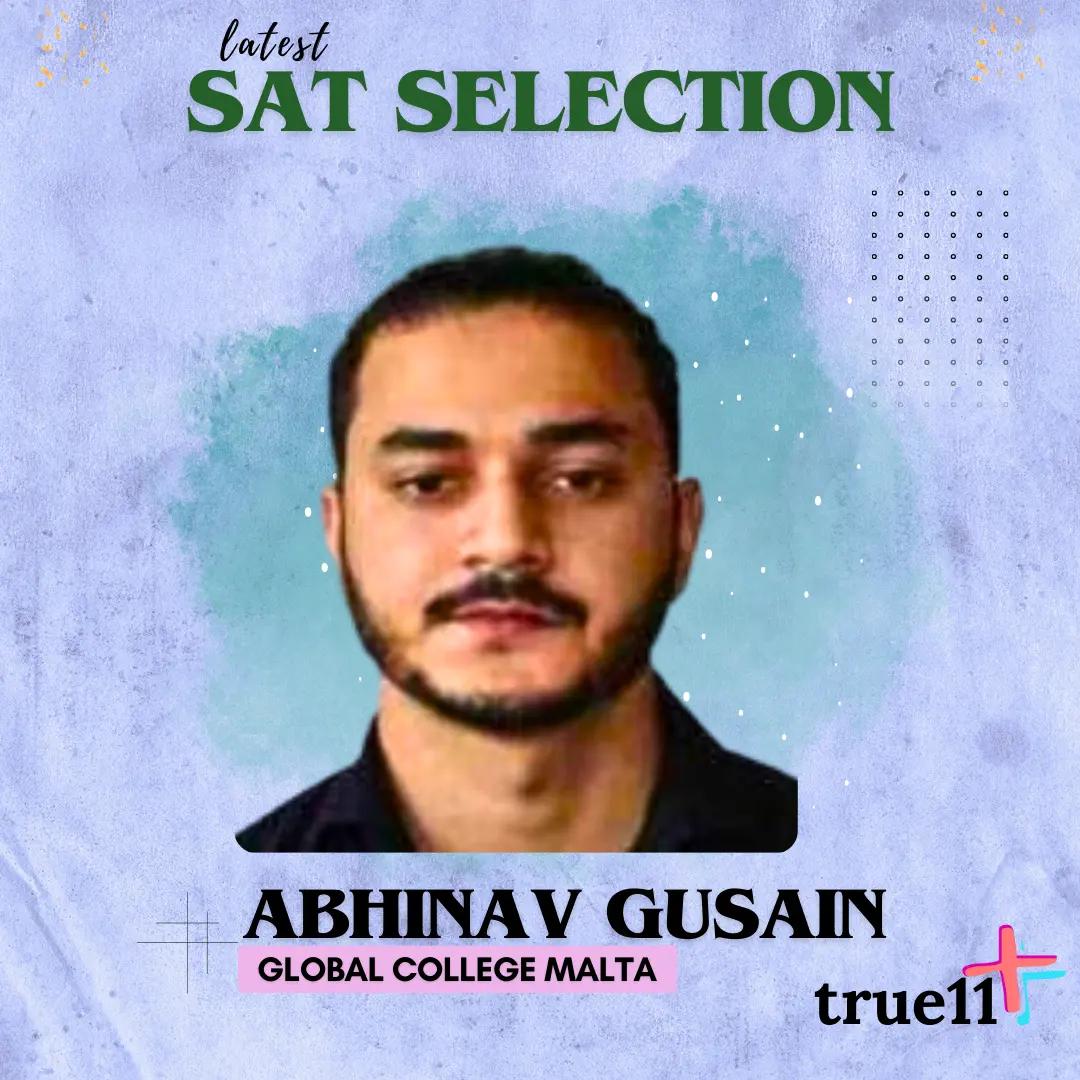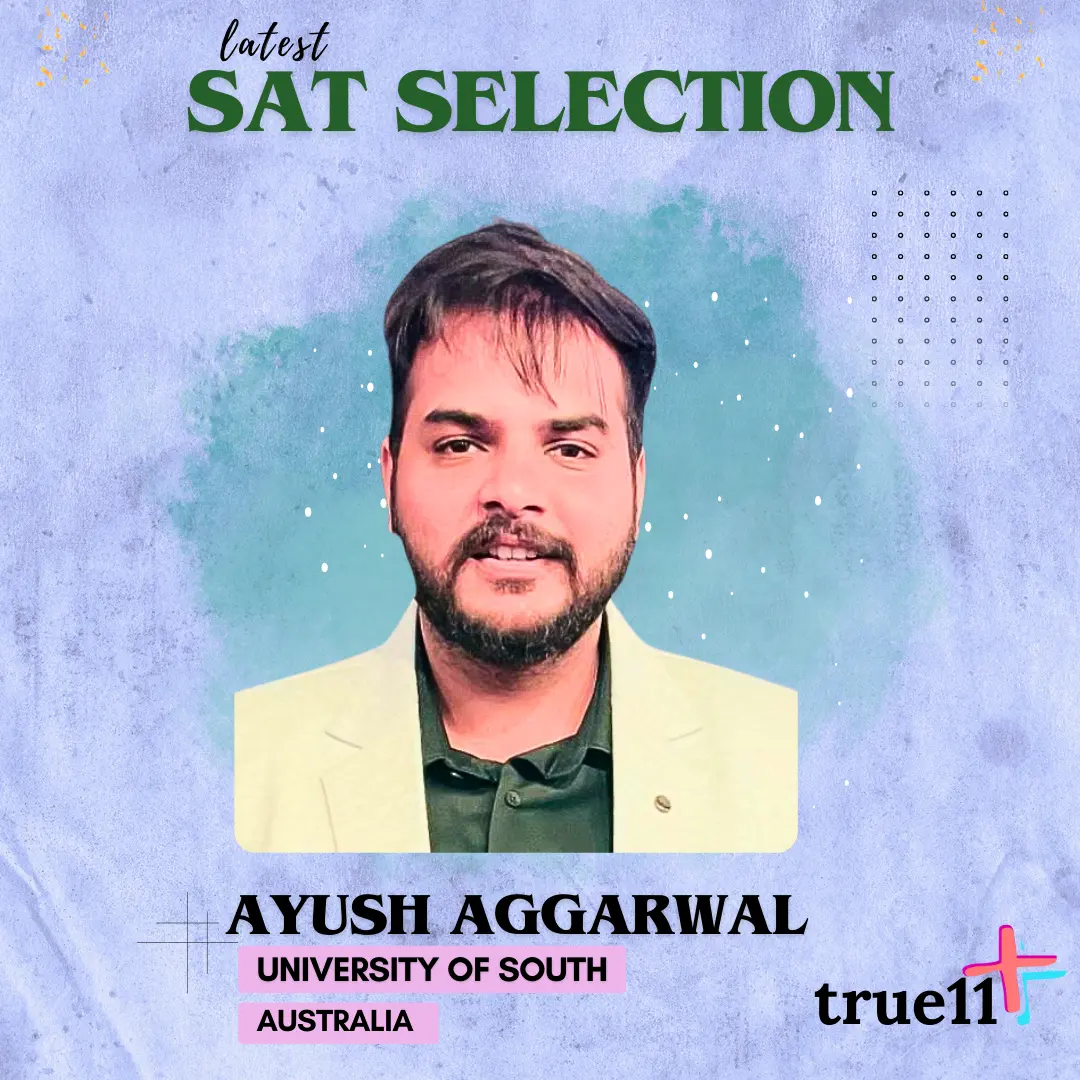
SAT Exam Coaching
Get ready for the SAT exam preparation with True11plus! Our expert coaches provide personalized coaching and strategies to help you ace the test. Boost your scores and increase your chances of getting into your dream college with True11plus SAT coaching. Join us now and achieve your academic goals!
Tailored study plans
Results-driven approach
Proven track record of success










Want to crack SAT Exam?
Prepare for SAT exam with True11 Plus
One-on-one tutoring sessions
Highly qualified and experienced faculties
Effective learning strategies
- Get a full-proof method to crack exams
- Faculty with over 20 Years+ experience
- Free Study Material
- Regular Mock Tests
Get Free Counselling
Meet Your Mentors
About SAT Exam
The SAT exam is a standardized test that is used by colleges and universities in the United States as part of their admissions process. The exam is designed to measure a student’s readiness for college-level work and assess their critical thinking and problem-solving abilities in various subjects such as mathematics, reading, and writing.
Many colleges and universities in the United States require or recommend that applicants take the SAT exam as part of their admissions process. The SAT provides a standardized measure of a student’s academic abilities, which helps colleges and universities evaluate applicants fairly and objectively.
Preparing for the SAT exam can be a challenging process, but with hard work and dedication, students can achieve a high score and increase their chances of being accepted to the colleges and universities of their choice. There are various resources available to help students prepare for the SAT, such as study guides, practice tests, and online courses.
In conclusion, the SAT exam is an important part of the college admissions process in the United States. By demonstrating their readiness for college-level work and their critical thinking and problem-solving abilities, students can increase their chances of being accepted to the colleges and universities of their choice. With the right preparation, students can achieve a high score on the SAT and set themselves up for success in college and beyond.
Digital SAT Exam Info
DIgital SAT Exam
The SAT tests skills that you are learning in high school—skills you’re likely to need in college and beyond. Here’s an overview of the content areas and question formats you can expect to see on the SAT:
English in Digital SAT
Evidence-based reading and writing
Words in context
You will be tested on words that appear frequently in high-school-level and college-level texts.
Range of sources
You’ll be asked to analyze, synthesize, and interpret data from a range of sources, including tables, charts, and graphs, as well as multi-paragraph passages in the following areas:
- Literature and literary nonfiction
- The humanities
- Science
- History and social studies
- Work and career
Command of evidence
For every passage or pair of passages you’ll see during the Reading Test, at least one question will ask you to identify which part of the text best supports the answer to the previous question. In other instances, you’ll be asked to find the best answer to a question by pulling together information conveyed in words and graphics.
The Writing and Language Test also focuses on command of evidence. It will ask you to analyze a series of sentences or paragraphs and decide if they make sense. Other questions will ask you to interpret graphics and to edit a part of the accompanying passage so that it clearly and accurately communicates the information in the graphics.
The Math that matters most in DIGITAL SAT
The Math Test focuses in depth on three essential areas of math: Problem Solving and Data Analysis, Heart of Algebra, and Passport to Advanced Math.
- Questions from the Problem Solving and Data Analysis area will require you to use ratios, percentages, and proportional reasoning to solve problems in science, social science, and career contexts.
- Questions from the Heart of Algebra area focus on the mastery of linear equations and systems, which help students develop key powers of abstraction.
- The Passport to Advanced Math questions focus on more complex equations and the manipulation they require.
Problems grounded in real-world contexts
Throughout the SAT—in the Math Test, the Reading Test, and the Writing and Language Test—you will be asked questions grounded in the real world, directly related to work performed in college and career.
Analysis in science and analysis in history/social studies
You will be asked to apply your knowledge in reading, writing, language, and math to answer questions in science and history/social studies contexts. Questions will require you to read and understand texts and to synthesize information presented through texts and graphics.
Founding documents and great global conversations
These reading passages focus on major founding political documents and the great global conversations they inspire.
DIgital SAT Study Plan
Month 1-
Week 1:
- Learn about digital SAT
- Get an idea of the syllabus
- Understand SAT Scoring system
- Analyse other resources for college admissions
- Give a practise test to understand area’s of strengths and weaknesses
- Complete maths,system of linear equations and word problems
Week 2:
- Maths Unit 1: Foundations: Algebra (including Unit test)
- RW Lesson: Foundations: Command of Evidence: Textual
- RW Lesson: Foundations: Command of Evidence: Quantitative
- RW Lesson: Foundations: Central Ideas and Details
- RW Lesson: Foundations: Inferences
Week 3:
- Maths Unit 2: Foundations: Problem solving and data analysis
- RW Lesson: Foundations: Words in Context
- RW Lesson: Foundations: Text Structure and Purpose
- RW Lesson: Foundations: Cross-Text Connections
- RW Lesson: Foundations: Transitions
Week 4+:
- Maths Unit 3: Foundations: Advanced maths
- Maths Unit 4: Foundations: Geometry and trigonometry
- RW Lesson: Foundations: Rhetorical Synthesis
- RW Lesson: Foundations: Form, Structure, and Sense
- RW Lesson: Foundations: Boundaries
- RW Foundations Unit test
Month 2-
Week 1:
- Take practice test 2.
- Get your score: how did you do compared to the last practice test? Be proud of any gains you’ve made—even small ones! Analyze the question-by-question breakdown. Read explanations and rationales for any questions you missed. Make note of any patterns: where have you improved, and where do you still need work?
- Maths Unit 5: Medium: Algebra( complete at least half the topics in this week)
- RW Lesson: Medium: Command of Evidence: Textual
Week 2:
- Maths Unit 1: Medium: Algebra (complete the remaining topics)
- RW Lesson: Medium: Command of Evidence: Quantitative
- RW Lesson: Medium: Central Ideas and Details
- RW Lesson: Medium: Inferences
Week 3:
- Maths Unit 2: Medium: Problem solving and data analysis
- RW Lesson: Medium: Words in Context
- RW Lesson: Medium: Text Structure and Purpose
- RW Lesson: Medium: Cross-Text Connections
Week 4 +:
- Maths Unit 3: Medium: Advanced maths
- Maths Unit 4: Medium: Geometry and trigonometry
- RW Lesson: Medium: Transitions
- RW Lesson: Medium: Rhetorical Synthesis
- RW Lesson: Medium: Form, Structure, and Sense
- RW Lesson: Medium: Boundaries
- RW Medium Practise test
Month 3:
Week 1:
- Take practice test 3
- Get your score: how did you do compared to the last practice test? Be proud of any gains you’ve made—even small ones! Analyze the question-by-question breakdown. Read explanations and rationales for any questions you missed. Make note of any patterns: where have you improved, and where do you still need work?
- Math Unit 10: Advanced: Algebra (complete atleast half the topics in this week)
- RW Lesson: Advanced: Command of Evidence: Textual
Week 2:
- Math Unit 1: Advanced: Algebra ( Complete the remaining topics)
- RW Lesson: Advanced: Command of Evidence: Quantitative
- RW Lesson: Advanced: Central Ideas and Details
- RW Lesson: Advanced: Inferences
Week 3:
- Maths Unit 2: Advanced: Problem solving and data analysis
- RW Lesson: Advanced: Words in Context
- RW Lesson: Advanced: Text Structure and Purpose
- RW Lesson: Advanced: Cross-Text Connections
Week 4 +:
- Maths Unit 3: Advanced: Advanced maths
- Maths Unit 4: Advanced: Geometry and trigonometry
- RW Lesson: Advanced: Transitions
- RW Lesson: Advanced: Rhetorical Synthesis
- RW Lesson: Advanced: Form, Structure, and Sense
- RW Lesson: Advanced: Boundaries
- RW Advanced Practise test
Month 4: Targeted Practice and Mastery
Week 1:
- Go back to the lessons in which you struggled the most in RW. Review the lessons and do more practice problems as needed. Revise all your shortcomings!
Week 2:
- Go back to the lessons in which you struggled the most in maths. Review the lessons and do more practice problems as needed. Revise all your shortcomings!
Week 3:
- Maths and RW: More practise tests with in depth SWOT analysis
Week 4 + (one to two weeks before your practice test):
- Take practice test 4 Get your score and analyze the question-by-question breakdown. Read explanations and rationales for any questions you missed. Compare your score to the score you got on practice test 1 and be proud of how far you’ve come!
DIgital SAT Syllabus
Digital SAT- Mathematics
*Please note that all the topics under the units are further sub-divided into 3 parts i.e: Foundation,Medium, Advanced).
For eg: Solving Linear equations and word inequalities is divided into 3 parts, foundations, medium and advanced.
Unit 1- Algebra
(i) Solving linear equations and word inequalities
(ii) Linear Equations word problems
(iii) Graphs of linear equations and functions
(iv) Solving system of linear equations
(v) Solving system of linear equations (word problems)
(vi) Linear Inequality word problems
(vii) Graphs of linear systems and inequalities
Unit 2- Problem Solving & Data Analysis
(i) Ratios, Rates & Proportions
(ii) Unit Conversions
(iii) Percentages
(iv) Center, Spread and shape of distributions
(v) Data representations
(vi) ScatterPlots
(vii) Linear and Exponential Growth
(viii) Probability and relative frequency
(ix) Data inferences
(x) Evaluating statistical claims
Unit 3- Advanced Math
(i) Factoring quadratic and polynomial expressions
(ii) Radicals and rational exponents
(iii) Operations with polynomials
(iv) Operations with rational expressions
(v) non-linear functions
(vi) Isolating Quantities
(vii) Solving Quadratic Equations
(viii) Linear and Quadratic Systems
(ix) Radical, Rational and absolute value equations
(x) Quadratic and exponential word problems
(xi) Quadratic Graphs
(xii) Exponential Graphs
(xiii) Polynomial and other non linear graphs
Unit 4- Geometry and trigonometry
(i) Area and Volume
(ii) Congruence, Similarity and angle relationships
(iii) Right triangle trigonometry
(iv) Circle Theorems
(v) Unit circle Trigonometry
(vi) Circle Equations
Digital SAT( Reading& Writing)- English
- Command of Evidence- Textual
- Command of Evidence- Quantitative
- Central ideas and details
- Inferences
- Words in Context
- Text structure and purpose
- Cross text connections
- Transitions
- Rhetorical Synthesis
- Form, Structure and Sense
- Boundaries
SAT Exam Info
SAT Exam Syllabus
The SAT exam consists of three main sections: Evidence-Based Reading and Writing, Math, and an optional Essay section. Each section has its own specific content and format. Here is an overview of the SAT exam syllabus:
1. Evidence-Based Reading and Writing:
- Reading: Passages from literature, history/social studies, and science. Focus on comprehension, inference, and vocabulary.
- Writing and Language: Questions on grammar, punctuation, and usage. Focus on improving the clarity and effectiveness of writing.
2. Math:
- Calculator section: Questions on algebra, geometry, and trigonometry. Focus on problem-solving and real-world applications.
- No-calculator section: Questions on algebra, geometry, and trigonometry. Focus on understanding concepts and applying mathematical reasoning.
3. Essay (optional):
- Analyze a given text and develop an argument. Focus on the effective use of evidence, reasoning, and language.
The SAT exam does not test specific content knowledge, but rather critical thinking, problem-solving, and analytical skills. It is important to be familiar with the format and content of the exam and to practice with sample questions and full-length practice tests.
SAT Exam Eligibility
The SAT exam is open to students of all ages, and there is no minimum or maximum age criteria or SAT age limit fixed for students wanting to appear for the exam. This means that students who are still in high school or those who have already graduated can take the SAT exam if they wish to apply for undergraduate studies in the United States. However, general studies have shown that students belonging to the age group of 17 to 19 are among the highest to appear for SAT.
Students can take the SAT exam as many times as they want, as there are no restrictions set by the College Board. However, it is important to note that some colleges and universities may consider all scores when evaluating an applicant’s SAT performance, while others may only consider the highest score. This means that students should carefully consider how many times they want to take the exam and ensure that they are adequately prepared each time.
While there are no specific eligibility criteria set by the College Board for the SAT exam, students who want to apply for undergraduate studies abroad are required to have successfully completed their high school education to move to the next level of their learning. This means that students should have a high school diploma or equivalent to be eligible to take the SAT exam. Additionally, students should also check with the specific colleges and universities they wish to apply to for any additional eligibility criteria or requirements.
SAT Exam Important Dates
Here are some of the important dates for the SAT exam:
- Registration Deadlines: The registration deadlines for the SAT vary depending on the test date. Typically, the registration deadline is about a month before the test date. You can find the registration deadlines on the College Board website.
- Test Dates: The SAT is offered several times a year, usually in August, October, November, December, March, May, and June. You can find the exact test dates on the College Board website.
- Score Release Dates: Your SAT scores are typically released about two weeks after you take the test. You can access your scores online through your College Board account.
It’s important to register for the SAT well in advance of the test date to ensure that you get a spot and have enough time to prepare. Keep in mind that some test dates may fill up quickly, so it’s a good idea to register as soon as possible.
SAT Exam Registration
To register for the SAT exam, students can visit the College Board website, which is the organization responsible for administering the test. Here are the steps to follow:
- Create a College Board account: To register for the SAT exam, students need to create an account on the College Board website.
- Choose a test date and location: Students can choose a test date and location that works best for them. The SAT exam is offered several times a year at various locations across the United States and internationally.
- Provide personal information: Students will need to provide their personal information, such as their name, date of birth, and high school information.
- Upload a photo: Students must upload a recent photo of themselves to their College Board account. This photo will be printed on their admission ticket and used for identification purposes on test day.
- Pay the registration fee: The cost of the SAT exam varies depending on whether the student is taking the optional essay section and where they are taking the test. Students can pay the registration fee online using a credit card, debit card, or PayPal.
After registering for the SAT exam, students will receive a confirmation email with their admission ticket. It is important for students to review their admission ticket carefully and make sure all the information is correct. On test day, students should bring their admission ticket, a photo ID, and several No. 2 pencils with erasers.
SAT Exam fees
The fees for taking the SAT exam vary depending on your location and whether you choose to take the optional essay section. In the United States, the base registration fee for the SAT exam is $55, and the fee for the optional essay section is an additional $16. In addition to these fees, there may be additional fees for late registration, changing your test center or test date, or other special requests.
There are also fee waivers available for eligible students who cannot afford to pay the full cost of the exam. Students who receive free or reduced-price lunch, are enrolled in certain federal programs, or meet other eligibility criteria can request a fee waiver through their school counselor.
It’s important to check with the College Board, the organization that administers the SAT, for the most up-to-date fee information and to see if you qualify for a fee waiver.
Looking to excel in SAT exam for the
academic year 2023-24?
Enrolling in a reliable coaching institute is a wise choice to prepare for the SAT Exam. For quality coaching, True11plus in Dehradun is an ideal option. This coaching center provides comprehensive guidance to students to help them achieve good marks in the entrance exam. True11plus designs its course modules to align with the syllabus of SAT exam.
FAQs
The SAT is a standardized test used for college admissions in the United States. It measures a student’s readiness for college-level work and is typically taken by high school juniors and seniors.
The SAT exam consists of three main sections: Reading, Writing and Language, and Math. There is also an optional Essay section.
The total testing time for the SAT is 3 hours and 50 minutes with the Essay section, and 3 hours without it.
The SAT is scored on a scale of 400-1600, with separate scores for each of the three main sections. The Essay section is scored separately.
You can register for the SAT exam online through the College Board website.
You will need to bring acceptable photo identification, your admission ticket, pencils and an approved calculator.
Most students take the SAT in their junior or senior year of high school. It’s a good idea to take the exam at least twice to improve your scores.
Yes, you can take the SAT exam as many times as you want. Colleges typically consider your highest scores
You can prepare for the SAT exam by studying the test material, taking practice exams, and working with a tutor or taking an SAT prep course.
Crack Entrance Exam in 1st attempt